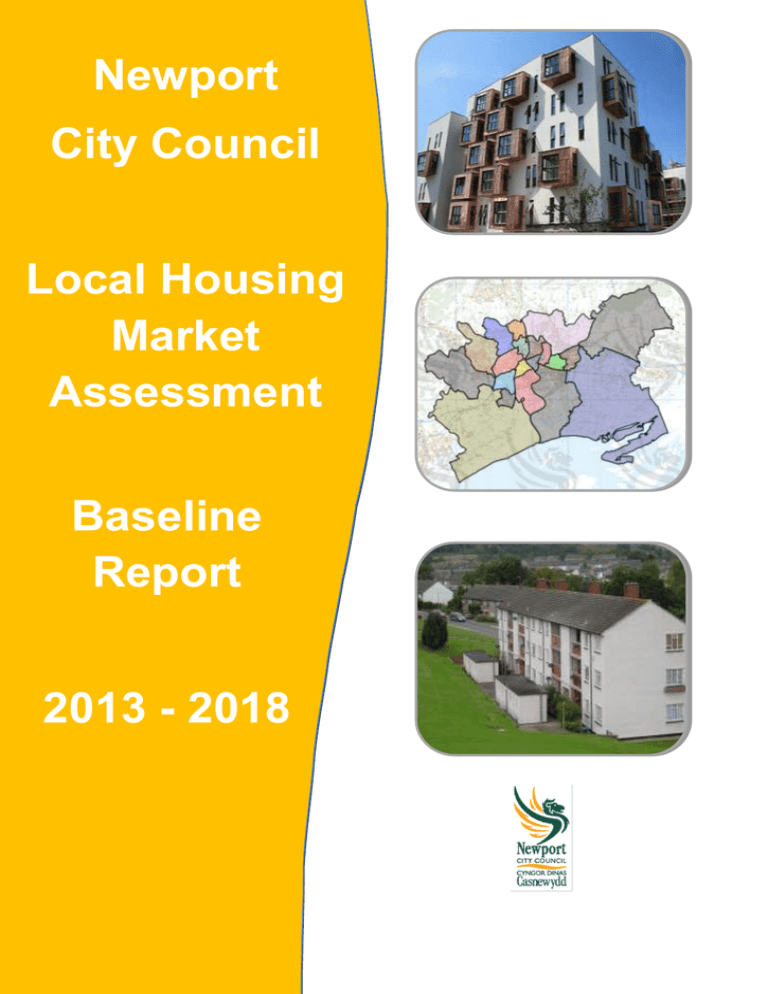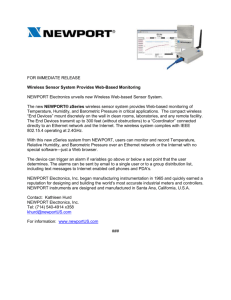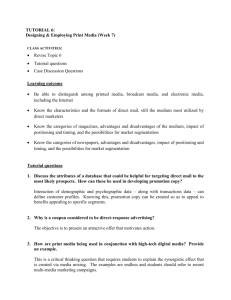Local Housing Market Assessment, Newport City Council, 2013
advertisement

Newport City Council Local Housing Market Assessment Baseline Report 2013 - 2018 Executive Summary Just the start!!! Executive Summary The production of Local Housing Market Assessments to identify housing need within a local authority area have been specified by Welsh Government in 2 main documents. “Local Housing Market Assessment Guide” was produced in March 2006, and the “Getting started with your Local Housing Market Assessment Guidance” was produced in June 2012. These documents provide a step by step guide and approved methodology to assess the housing market. The guide enables authorities to derive overall figures for the number of households requiring additional housing in their areas, and to determine what this means in terms of market and affordable housing provision. Based upon this assessment, authorities will then have the basis to develop sound planning policies, including affordable housing policies, in their Development Plans to provide the right mix of housing in terms of tenure. The analysis takes account of household projections, homelessness data, house prices, rental prices, household incomes, dwelling stock turnover, housing supply data and an analysis of the common housing register. Newport City Council with partner housing associations operates a Common Housing Register which has eliminated any potential double counting of applicants and has provided greater detail of information regarding housing applicants. The Common Register was introduced in April 2012 and involved a re-registration of all applicants ensuring that data was current. Like many areas property prices in Newport have fluctuated significantly in the last 10 years. In June 2007 the average property price in the city reached a peak of over £170,633 before declining dramatically. Since then property prices have begun to recover but the average price has remained below that of the Wales average since June 2008. Between 2001 and 2011 Newport saw its resident population grow from 137,011 people in 2001 to 145,736 in 2011. One of the reasons for this is Newport’s relatively youthful population. Between 2001 and 2011 many of the population that were children in 2001 would have grown up and had families of their own. Another reason is increased migration to Newport, particularly international migration. At the time of the 2011 census around 5% of Newport’s population was born outside the UK. Undertaking this housing market assessment has identified the need for 593 new affordable housing units per year. However these figures are not annual delivery targets as new build homes are not the total solution to the supply of affordable homes for the City. The City Council are working extensively with the owners of private sector empty homes within Newport as well as private sector landlords in order to increase the supply of affordable rented accommodation. Provision of smaller private rented accommodation through sub division of existing properties also increase the supply of available homes. Carrying out a Local Housing Market Assessment is a complex process, and involves analysing a range of data to try and understand the intricacies of housing demand and supply. Whilst this Assessment does not provide all the answers it is hoped that it will act as a framework for the local authority and its partners to address housing need in Newport. 2 Contents 1. Introduction................................................................................................................................ 4 1.2. National Policy Framework ................................................................................................. 4 1.2.1. Planning Policy Wales .................................................................................................. 4 1.2.7. Local Housing Strategy 2012-2017 .............................................................................. 5 1.2.13. 1.3. Local Development Plan ........................................................................................... 6 Methodology for assessing housing need ........................................................................... 6 2. Housing Market Analysis ........................................................................................................... 9 2.1. Average House Prices ........................................................................................................ 9 2.2. Dwelling Stock Turnover ................................................................................................... 12 2.3. Market Rents .................................................................................................................... 17 3. Analysis of the waiting list and 2011 census data ................................................................... 18 3.1. Household Composition .................................................................................................... 18 3.2. Socio-Economic Analysis.................................................................................................. 20 3.2.1. Qualifications and Occupations .................................................................................. 20 3.2.3. Household Income ..................................................................................................... 22 3.3. Reasons for Moving .......................................................................................................... 23 3.4. Geographical Trends and Preferences ............................................................................. 25 4. Detailed housing market analysis, including tables ................................................................. 28 4.1. Newly arising housing need .............................................................................................. 28 4.2. Existing households falling into need ................................................................................ 30 4.3. Backlog of housing need................................................................................................... 31 4.4. Supply of affordable housing ............................................................................................ 32 4.5. Total net need for affordable housing ............................................................................... 33 4.6. Status of headline figures ................................................................................................. 34 5. Conclusion............................................................................................................................... 35 Bibliography ................................................................................................................................... 37 Appendix 1 ..................................................................................................................................... 38 3 1. Introduction 1.1. Local Housing Market Assessments are a crucial part of the evidence base for preparing Development Plans and Local Housing Strategies. 1.2. National Policy Framework 1.2.1. Planning Policy Wales 1.2.2. Planning Policy Wales (PPW) updated in November 2012 by the Welsh Government (WG) provides the overarching national strategic guidance with regards to land use planning matters in Wales. Paragraph 4.4.3 states that Local Planning Authorities should: “Ensure that all local communities - both urban and rural - have sufficient good quality housing for their needs, including affordable housing for local needs and for special needs where appropriate, in safe neighbourhoods.” 1.2.3. The housing section of Planning Policy Wales (November 2012) (paragraph 9.1.2) seeks the promotion of sustainable mixed tenure communities. It states: “Local planning authorities should promote sustainable residential environments, avoid large housing areas of monotonous character and make appropriate provision for affordable housing.” 1.2.4. With regard to need, paragraph 9.2.14 states: “A community’s need for affordable housing is a material planning consideration which must be taken into account in formulating development plan policies.” 1.2.5. Affordable housing is defined in paragraph 9.2.14 of PPW as: “Affordable housing for the purposes of the land use planning system is housing where there are secure mechanisms in place to ensure that it is accessible to those who cannot afford market housing, both on first occupation and for subsequent occupiers. However, it is recognised that some schemes may provide for staircasing to full ownership. Where this is the case there must be secure arrangements in place to ensure the recycling of capital receipts to provide replacement affordable housing. Affordable housing includes social rented housing owned by local authorities and registered social landlords and intermediate housing where prices or rents are above those of social rent but below market housing prices or rents. All other types of housing are referred to as ‘market housing’, that is private housing for sale or rent where the price is set in the open market and occupation is not subject to control by the local planning authority.” 1.2.6. Where development plan policies make it clear that an element of affordable housing will be required, paragraph 9.3.5 states: “Applicants for planning permission should therefore demonstrate and justify how they have arrived at a particular mix of housing, having regard to development plan 4 policies. If, having had regard to all material considerations, the local planning authority considers that the proposal for a site does not contribute sufficiently towards the objective of creating mixed communities, then the authority will need to negotiate a revision of the mix of housing or may refuse the application. “proposal for a site does not contribute sufficiently towards the objective of creating mixed communities, then the authority will need to negotiate a revision of the mix of housing or may refuse the application.” 1.2.7. Local Housing Strategy 2012-2017 1.2.8. Local Housing Strategies outline the areas of work within housing that the local authority is required to achieve. Newport City Council no longer has a stock of council housing, as this has been transferred to a newly created housing association. However, the Council has numerous statutory duties to perform and targets to achieve, including maintaining a housing register, allocating social housing grant, providing housing advice, assisting the improvement of the energy efficiency of the existing housing stock and providing disabled adaptations to name just a few. Newport’s Local Housing Strategy is based on extensive consultation with the people of the City. Throughout the summer of 2011 the Council went out into the community and asked people in Newport what major housing issues were there in the city. The main themes of this document come directly from this consultation. 1.2.9. The strategy also reflects major legislative changes that occurred after the consultation period ended. In early 2012 the Welfare Reform Act became law, and with it began a series of major changes to the benefits system and these also needed to be taken into account and will have an impact on the numbers of people in housing need. Newport is a growing city; its population is expected to increase by over 4% between 2010 and 2020 with more people living alone, and more people aged over 65. We need to make sure that, as far as possible, the city’s housing stock matches the needs of the people who want to live here. 1.2.10 Most Newport households live in owner-occupied homes but the local housing market has been affected by the UK’s economic recession and the banking crisis. Mortgage lending has been tightened up and many would-be first-time buyers are unable to buy a home. This means that not only are younger people finding it more difficult to afford their first home, but others may not be able to sell when they need to. More owner-occupiers may have to stay in accommodation which is unsuitable for them and will be in need of help, such as a Disabled Facilities Grant. The City Council and partner housing associations are currently reviewing the provision of older person’s housing, looking at modernisation of some schemes and identifying gaps in provision where new build schemes will be required. 1.2.11 Newport City Council is targeting empty properties within the City and assisting owners where possible to bring them back into use; though this does not necessarily increase the supply of new homes it ensures properties are appropriately utilised and often provides more affordable properties in areas of the City where new developments may not be possible due to limited land supply. 1.2.12 Due to the current conditions in the housing market, more people are expected to turn to the private rented sector; Newport City Council aims to work with private 5 landlords providing advice and assistance to ensure properties are of an appropriate standard and tenancies are maintained. All new build affordable housing will be required to meet appropriate quality standards set by Welsh Government which will ensure they address the needs of the population by providing appropriate space standards, are economical to maintain and heat and provide a safe home in an attractive neighbourhood. Affordable housing in Newport is allocated on a neutral tenure basis, this means the tenure is determined by the resident’s financial circumstances, if they are able to invest in the property that option is available or they can chose to rent their home, over time their situation and subsequently tenure can change. 1.2.13 Local Development Plan 1.2.14 The Council is preparing the Local Development Plan for Newport. The development plan provides the basis for determining planning applications and sets the framework for the delivery of affordable housing through the planning system in the County Borough. Additional affordable housing will be secured through application of Policy H4 to residential proposals. 1.3 Methodology for assessing housing need 1.3.1 This Local Housing Market Assessment (LHMA) has utilised the Welsh Government’s approved methodology. The guide ‘Getting Started on your LHMA - a step by step guide’ has been developed to supplement the comprehensive and detailed Welsh Assembly Government LHMA guidance (Welsh Assembly Government 2006b) which underlines the need for Authorities to take a strategic approach to addressing housing need, including the housing needs of the growing population of older people. The guide outlines a quantitative approach to calculating housing need which can be used consistently across Local Authorities. It also aims to help Authorities to undertake their own assessment of the housing market. 1.3.2 The guide uses the bath analogy developed by Glen Bramley, Bramley et al. (1998, p.34), to model and assess housing need. The model conceptualises “newly arising (housing) need as water from the taps, new [affordable] housing provision as water escaping through the plughole, and the backlog (of housing need) as the level of water in the bath”. The model has been expanded in the guide to take into account the broader housing market. The development of a LHMA is often described as “more of an art than a science” and therefore the ‘headline’ housing need figure calculated by this approach should not be used as a definitive measure of need or as a target figure. Rather it should be used to improve the scale of local housing need. Approaches to meeting the need for affordable housing will include (but are not limited to) provision through Social Housing Grant, Section 106 contributions, selffunded Registered Social Landlord Schemes and refurbishment of private sector empty properties. 6 1.3.3 For planning purposes, the outputs required from the Local Housing Market Assessment can be derived using only secondary data, enabling local planning authorities to move quickly to the policy approach towards mixed communities set out in Planning Policy Wales,TAN 1 and TAN 2. Large-scale data collection exercises such as a local household survey aren’t necessary to achieve the requirements of this policy approach provided that there is sufficient information from other sources to estimate housing requirements and the need for affordable housing. With the release of the 2011 census data, CACI pay check information as well as a new robust common housing register etc. the information to assess need is extremely comprehensive in Newport. 1.3.4 The common housing register in Newport is utilised by all housing associations operating in the City. All applicants for all tenures are registered on one list which ensures there is no possibility of double counting. All homeless households are also included within this common register. Applicants are contacted on an annual basis to up-date their details and confirm that they are still seeking housing. As the system is web based it allows people to up-date their details easily on line so that circumstances can be amended in a timely fashion. The system provides the mechanism to undertake a thorough analysis of the information held on the waiting list and determine the need for affordable housing, the required location, size and tenure. 1.3.5 The housing market information has been analysed at ward level, however there are six clear sub market areas within the City and details have been provided at these levels, in clear recognition that housing markets do not respect administrative boundaries. The areas are:- Rural hinterland, Central Newport, Inner Core Higher value, Inner Core Lower value, Outer Core Higher value, Outer Core Lower value. 7 Figure 1 - Newport Sub Market Areas 2 Housing Market Analysis 2.1 Average House Prices 2.1.1 Average property prices in Newport increased dramatically over a number of years before peaking in November 2007. Since that time there has been a fluctuating decline in prices, but prices have not returned to anywhere near the levels of the early part of the last decade. Figure 2 - Newport Average Property Prices, Source: Hometrack February 2013 2.1.2 Looking at the average property price for Newport as whole masks significant differences in property prices across the city. Unsurprisingly property prices were higher in the rural hinterland submarket area – Graig, Langstone, Llanwern, Marshfield and Tredegar Park. The lowest prices were found in the inner core lower value areas of Pillgwenlly and Victoria. Outer Area Lower Value Central Newport Gaer £126,975 Alway ED £121,537 Liswerry £109,176 Beechwood £116,868 Shaftesbury £101,065 Bettws £92,725 St. Julian’s £123,928 Malpas £134,130 Ringland £110,135 Inner Core Higher Value Allt-yr-Yn £198,060 Stow Hill £135,375 Rural Hinterland Graig £221,375 Inner Core Lower Value Langstone £292,774 Pillgwenlly £97,100 Llanwern £182,338 Victoria £90,147 Marshfield £292,942 Tredegar Park £158,654 Outer Area Higher Value Caerleon £197,300 Rogerstone £180,213 Figure 3 - Average Property Price by Ward, Source: Hometrack February 2013 10 2.1.3 Property size is a key factor in determining the price of the property, as the chart below shows. Figure 4 - Average Property Price by Size, Source: Hometrack February 2013 2.1.4 Properties located within Newport’s rural hinterland tend to be larger and detached; whereas properties in the lower value inner core areas tend to be traditional terraced properties. 11 2.2 Dwelling Stock Turnover 2.2.1 The chart below shows that there has been a significant decrease in dwelling stock turnover in Newport in the last few years. Sales have fallen from 1,392 in 2008 to 874 in 2012. The greatest decrease has been in the sale of flats. Figure 5 - Turnover by Property Type, Source: Hometrack February 2013 12 2.2.2 Second hand property sales account for the majority of all housing sales. New build property sales, especially new build flats have seen a significant decline since 2008. Figure 6 - Turnover by Type and Age, Source: Hometrack February 2013 13 2.2.3 In terms of sale prices the graph below shows that over the half the properties that were sold in Newport in 2011 had a selling price of between £75,000 and £150,000. Sales tapered off as they reached the higher end of the scale but there were a small but significant number of properties that sold for over £500,000. Figure 7 - Turnover by Sale Price, Source: Hometrack February 2013 14 2.2.4 There has been a significant amount of variance in the time it has taken properties to sell over the last two years. In February 2012 properties, on average, took a record 16 and a half weeks to sell. By the summer this had fallen to just over 4 weeks before rising again in the autumn. Figure 8 - Time to Sell, Source: Hometrack February 2013 15 2.2.5 Despite the vitality in the market seen above average sales to asking price have remained fairly constant over the last few years with a slow but consistent rise from October 2011. Figure 9 - Sales to Asking Price, Source: Hometrack February 2013 16 2.3 Market Rents 2.3.1 As mortgage availability has prevented many people from entering the owner occupied sector the private rented sector has become an increasingly important part of Newport’s housing market. In 2001, 3,069 households lived in the private rented sector in Newport, by 2011 this had increased to 8,572. Other factors that will have led to an increase in households living in the private rented sector are increased migration to Newport, the city becoming an asylum dispersal area and the continuing growth of the student population. The highest proportions of privately renting households are found in the inner core areas, although there were also significant numbers of households living in the private rented sector in the central Newport area. Households Figure 10 - Households in the Private Rented Sector, Source: Census 2011 No. % Central Newport 2,220 15% Inner Core Higher Value 1,347 22% Inner Core Lower Value 1,884 31% Outer Area Higher Value 736 10% Outer Area Lower Value 1,438 9% Rural Hinterland 947 10% 2.3.2 The highest median private rental prices in Newport are to be found in the rural hinterland. This is partly due to the scarcity of supply as well as the size and quality of properties available. 2.3.3 Changes to local housing allowance rates are likely to have a significant impact on the private rented market in Newport. Previously Local Housing Allowance was set at the median point of private rents in a local area. Now it will be set at a level where only the bottom 30% of rents are wholly covered by Local Housing Allowance. 17 3 Analysis of the waiting list and 2011 census data 3.1 Household Composition 3.1.1 The recent release of the 2011 census data has provided a valuable source of information as well as the details which can be obtained from applicants on the Common Housing Register. 3.1.2 Newport is one of the most densely populated areas of Wales. At the time of the 2011 census Newport’s usual resident population of 145,736 meant that there was a population density of 7.6 people per hectare. Of the Welsh local authorities only Cardiff had a higher population density. 3.1.3 The chart overleaf shows the most common household type in Newport at the time of the 2011 census. This was married couple households with 2 or more dependent children. This partly explains why Newport’s population is so youthful. 19% of Newport’s population is aged under 15, the greatest proportion of any local authority in Wales. 16% of Newport’s population is aged 65+ but this is significantly lower than the Welsh average. Only Cardiff has fewer older people as a proportion of their population. 3.1.4 Households in Newport most commonly live in terraced properties, with a third of the population living in a terraced or end of terrace property. Owner occupation is the predominant tenure in Newport, with just over 39,000 households, 64%, owning their own property. Of these just over 18,000 households live in a property that they own outright. Just over 12,000 households, 20%, live in a socially rented property significantly higher than the all Wales figure of 17%. 18 Household Types One Person: Aged Over 65 One Person: Other One Family: All Over 65 0.9% One Family: Married, No Children 0.3% 2.9% 4.3% 2.4% 5.5% 7.6% 3.6% 6.8% 6.0% 4.9% 9.4% 0.8% 4.4% 2.8% 8.0% 3.8% 0.1% 8.3% 17.3% One Family: Married, 1 Dependent Child One Family: Married, 2 or More Dependent Children One Family: Married, All Children Non Dependent One Family: Same Sex Civil Partnership, No Children One Family: Cohabiting Couple, No Children One Family: Cohabiting Couple, 1 Dependent Child One Family: Cohabiting Couple, 2 or More Dependent Children One Family: Cohabiting, All Children Non Dependent One Family: Lone Parent, 1 Dependent Child One Family: Lone Parent, 2 or More Dependent Child One Family: Lone Parent, All Children Non Dependent Other: 1 Dependent Child Other: 2 or More Dependent Children Other: All Students Other: All Aged 65+ Other:Other Figure 11 - Newport Household Types, Source: Census 2011 19 3.2 Socio-Economic Analysis 3.2.1 Qualifications and Occupations People in Newport, and the former Gwent region as a whole were more likely to have no qualifications than in Wales as a whole. Newport was more likely to have residents that held foreign qualifications, reflecting the increasing diversity of the city. 40% 35% 33.50% 31.20% 30.89% 30% 27.58% 27% 25.90% 25% 20% 15.80% 15% 14.30% 14.10% 13.44% 13.60% 12.85% 10% 12.60% 5% 13.60% 13.41% 3.70% 2.60% 2.31% 0% Newport Gwent Wales No Qualifications 5 GCSEs A-C (or equivalent) 2 A Levels (or equivalent) Degree of Higher Degree Professional Qualification Foreign Qualification Figure 12 - Qualifications, Source: Census 2011 20 3.2.2 Newport has higher numbers of people employed in higher managerial professions than the Wales average, but also more people who have never worked or are long term unemployed. The most common sectors of work for people in Newport were sales assistants and cashiers, caring personal services and teaching and educational professionals. 25% 20% 15% 10% 5% Newport Gwent Never worked and long-term unemployed Routine occupations Semi-routine occupations Lower supervisory and technical occupations Small employers and own account workers Intermediate occupations Lower managerial, administrative and professional occupations Higher managerial, administrative and professional occupations 0% Wales Figure 13 - Occupation, Source: Census 2011 21 3.2.3 Household Income 3.2.4 Newport has a slightly higher median income than the all Wales figure, but the median income for the UK as a whole is significantly higher. £30,000 £28,318 £25,952 £24,848 £25,000 £20,000 £15,000 £10,000 £5,000 £0 Newport Wales UK Figure 14 Average Household Incomes, Source: CACI PayCheck 2012 22 3.3 Reasons for Moving 3.3.1 As of the end of February 2012 there were 4,308 active applications on the common housing register. These applications are subject to an annual review to ensure information is up to date and people still require assistance with housing. Applicants provide detailed information which provides an insight into their current housing circumstances and their housing needs and aspirations. 3.3.2 As of the beginning of February 2013 the most common reasons why people with active applications on the common housing register wanted to move were: Health/medical reasons – 16% No permanent home – 11% Overcrowding – 10% 3.3.3 If we analyse applications in the context of submarket areas we can see that there are fewer applications from areas where property prices are higher. This may be because people who live in these areas tend to have sufficient income to meet their own housing need in the private market. 23 Housing Applications by Sub Market Areas 305 1058 949 Central Newport Inner Core Higher Value Inner Core Lower Value 307 279 Outer Area Higher Value Outer Area Lower Value 983 Rural Hinterland Figure 15 - Source: Newport Common Housing Register February 2013 3.3.4 The reasons for rehousing by submarket area also showed some variation. Households in the lower value areas were more likely to be seeking rehousing because of overcrowding. People living in the Outer Area Higher Value area were more likely to be seeking rehousing because of financial difficulties. Further analysis of this data showed that 2 thirds of the applicants living in Outer Area Higher Value areas that were seeking rehousing because of financial problems were living in the private rented sector. 24 Central Newport Outer Area Higher Value Health / Medical Reasons 19% Health / Medical Reasons 24% Overcrowding 10% Financial Difficulties 8% No Permanent Home 9% Overcrowding 8% Inner Core Higher Value Outer Area Lower Value No Permanent Home 16% Health / Medical Reasons 15% Asked to Leave by Family / Friends 11% Overcrowding 13% Health / Medical Reasons 10% Asked to Leave by Family / Friends 9% Inner Core Lower Value Rural Hinterland No Permanent Home 14% Health/Medical Reasons 17% Health / Medical Reasons 12% Overcrowding 11% Overcrowding 10% Asked to Leave by Family / Friends 9% Figure 16 - Source: Newport Common Housing Register February 2013 3.3.5 People living in the higher value areas were also more likely to be seeking rehousing because of health or medical problems. This is probably due to the age profiles of applicants from these areas, with 25% being aged 65+ compared to 19% of applicants from lower value areas. 3.4 Geographical Trends and Preferences 3.4.1 The chart below shows the areas applicants on the common housing register wanted to move to compared to where they lived at the present time. Lower value areas generated significantly more of their own demand than higher value areas. This may be because applicants do not wish to leave the area they currently live in or because they are making pragmatic decisions about where they think properties are most likely to become available. 25 Areas of Preference by Areas of Residence 60% 50% 40% 30% 20% 10% 0% Central Newport Inner Core Higher Inner Core Lower Value Value Outer Area Higher Value Outer Area Lower Rural Hinterland Value Area of Residence Central Newport Inner Core Higher Value Inner Core Lower Value Outer Area Higher Value Outer Area Lower Value Rural Hinterland Figure 17 - Source: Newport Common Housing Register February 2013 3.4.2 7% of applications on the waiting list came from people living outside Newport. Unsurprisingly most were from people living in neighbouring local authority areas. 26 Area of Residence - Applicants Outside Newport 7 7 6 5 5 8 71 21 23 34 62 37 Caerphilly Torfaen Monmouthshire England - Other Cardiff Wales - Other Blaenau Gwent London Scotland Swansea Bridgend Bristol Figure 18 - Source: Newport Common Housing Register February 2013 27 4 Detailed housing market analysis, including tables 4.1 Newly arising housing need 4.1.1 As the table below shows 3,066 households are projected to form within Newport over the next 5 years. Much of this change is accounted for amongst smaller households – those with one person or 2 adults without children. It does not necessarily follow that this will be matched by an equivalent increase in demand for smaller properties, many households, especially those accessing accommodation in the private sector will chose a property with more bedrooms than they technically need if they can afford to do so. 2012 2013 2014 2015 2016 2017 Change 18,291 18,463 18,771 19,097 19,450 19,815 1,524 1 person 2 person (no children) 2 person (1 adult, 1 child) 3 person (no children) 3 person (2 adults, 1 child) 3 person (1 adult, 2 children) 4 person (no children) 4 person (2+ adults, 1+ children) 4 person (1 adult, 3 children) 5 + person (no children) 5 + person (2+ adults, 1+ children) 5 + person (1 adult, 4 + children) 18,504 18,617 18,877 19,132 19,417 19,698 1,194 3,189 3,236 3,326 3,416 3,510 3,609 420 3,266 3,235 3,240 3,242 3,249 3,259 -7 4,233 4,227 4,276 4,322 4,376 4,419 186 2,014 2,039 2,088 2,142 2,201 2,264 250 773 749 737 723 710 698 -75 4,988 4,868 4,811 4,764 4,714 4,667 -321 678 683 695 710 728 746 68 114 109 107 104 101 99 -15 2,907 2,829 2,789 2,758 2,727 2,702 -205 346 351 359 369 381 393 59,303 59,406 60,076 60,779 61,564 62,369 47 3,066 Total Figure 19 - Household Projections, Source: Newport Local Housing Market Assessment 28 4.1.2 Welsh Government household projections are limited in so much as they are only available at local authority level. In order to disaggregate population growth to a ward level a further set of calculations is required to apply the projected growth to each ward based on the proportional number of households in each ward. The limitation of this approach is that it assumes that people would stay in the ward they currently live in. Analysis of population change between 2001 – 2011 shows that this is not the case. 4.1.3 Many of the areas that have seen the greatest increases in population are also the areas where most house building has taken place. This indicates that even though people may express a preference for staying in their local area, ultimately many people will go where there is housing available. This may be even more apparent in affordable housing where people may have the choice of waiting longer for an older property to become available in their preferred area or moving slightly further away to a new build property. Inward migration has also been a significant factor in population growth, especially in the inner core lower value areas. Predicted Annual Change 2012 - 2017 Actual Annual Change 2001 2011 Central Newport 149 147 Inner Core Higher Value 60 53 Inner Core Lower Value 61 275 Outer Area Higher Value 76 70 Outer Area Lower Value 170 93 Rural Hinterland 99 418 Figure 20 - Predicted and Actual Population Change, Source: Newport Local Housing Market Assessment and Census 2011 4.1.4 Not all these newly emerging households will need affordable housing. A key part of the LHMA is calculating the number of people priced out of the market and the form of affordable housing that they require. 29 4.2 Existing households falling into need 4.2.1 In addition to newly forming households falling into need a proportion of existing households will also fall into need in any given year due to homelessnes. This has been calculated at an additional 499 people each year. 2 Bed 3 Bed Allt-yr-Yn 1 Bed 14.74 2.49 4 Bed+ 2.49 11.26 Alway 12.64 Beechwood 30.98 9.66 2.13 2.13 26.56 12.74 9.73 2.15 2.15 26.77 Bettws 12.83 9.80 2.17 2.17 26.97 Caerleon 13.33 10.18 2.25 2.25 28.01 Gaer 14.92 11.40 2.52 2.52 31.36 Graig 9.55 7.29 1.61 1.61 20.06 Langstone 6.80 5.19 1.15 1.15 14.29 Liswerry 18.97 14.49 3.20 3.20 39.86 Llanwern 4.75 3.63 0.80 0.80 9.98 13.06 9.97 2.20 2.20 27.43 Marshfield 9.69 7.40 1.64 1.64 20.37 Pillgwenlly 11.48 8.77 1.94 1.94 24.13 Ringland 14.38 10.98 2.43 2.43 30.22 Rogerstone 16.41 12.53 2.77 2.77 34.48 Shaftesbury 9.24 7.06 1.56 1.56 19.42 14.19 10.84 2.39 2.39 29.81 Stow Hill 8.56 6.54 1.45 1.45 18 Tredegar Park 7.21 5.51 1.22 1.22 15.16 11.97 9.14 2.02 2.02 25.15 Malpas St. Julians Victoria Total Figure 21 - Households Falling Into Need, Source: Newport Local Housing Market Assessment 30 4.3 Backlog of housing need 4.3.1 As well as newly arising need there is also a backlog of housing need that must be addressed. The current annual need for affordable housing in order to meet the backlog is 831 units. 1 Bed 2 Bed 3 Bed General Sheltered General Sheltered General Sheltered Needs Needs Needs Allt-yr-Yn 34.63 9.87 18.02 0.81 5.84 0.59 4 Bed+ General Needs 3.27 Alway 12.26 3.45 7.09 0.42 2.20 0.35 1.12 Beechwood 6.18 1.34 4.10 0.18 1.31 0.10 0.54 Bettws 10.57 2.99 6.40 0.26 1.95 0.21 0.96 Caerleon 12.58 4.34 7.54 0.42 2.57 0.32 0.91 Gaer 29.74 9.18 15.79 0.75 5.20 0.64 2.81 Graig 7.85 2.17 4.69 0.19 1.53 0.21 0.69 Langstone 16.99 5.25 9.34 0.46 3.08 0.53 1.50 Liswerry 10.89 3.27 5.92 0.29 1.96 0.26 1.10 Llanwern 42.94 10.52 28.11 1.13 7.89 0.97 4.52 Malpas 19.27 5.95 11.43 0.51 3.56 0.35 1.95 Marshfield 15.96 5.20 8.89 0.34 2.60 0.46 1.44 Pillgwenlly 11.56 3.14 6.18 0.34 1.88 0.19 1.05 Ringland 22.11 7.14 12.64 0.86 3.94 0.40 1.69 Rogerstone 9.72 2.27 6.02 0.22 1.98 0.24 0.80 Shaftesbury 22.70 5.99 12.05 0.43 3.43 0.34 2.01 St. Julian’s 17.43 4.82 11.02 0.56 3.86 0.34 1.52 Stow Hill 30.64 7.22 14.69 0.57 5.08 0.48 2.60 Tredegar Park 7.34 2.41 4.28 0.22 1.26 0.16 0.59 Victoria 22.97 4.98 13.44 0.73 3.98 0.37 1.88 Figure 22 – Backlog of Housing Need, Source: Newport Local Housing Market Assessment 31 4.4 Supply of affordable housing 4.4.1 Much of this identified need will be met by existing or planned affordable housing supply. It is projected that 1,009 lets of social housing will be made each year. In addition a confirmed minimum of 37 new affordable housing units will be provided each year as shown in Appendix 1. General Needs Allt-yr-Yn 1 Bed Sheltered General Needs 2 Bed Sheltered General Needs 3 Bed Sheltered 4 Bed+ General Needs 25.33 0.00 22.33 0.00 7.00 0.00 0.67 Alway 9.00 0.00 23.73 0.33 27.07 0.00 2.67 Beechwood 2.00 0.00 3.33 1.20 0.33 0.00 0.00 41.67 1.33 48.33 0.67 21.00 0.00 1.00 3.00 9.67 13.33 1.67 2.00 0.00 0.00 Gaer 16.33 6.00 31.00 0.33 19.67 0.00 1.67 Graig 7.33 0.00 5.47 3.60 1.67 0.00 1.07 Langstone 0.67 0.00 4.53 0.00 1.20 0.00 0.00 Liswerry 6.33 5.33 46.00 0.00 36.00 0.00 4.67 Llanwern 1.33 2.00 4.33 0.33 3.67 0.00 0.00 Malpas 2.33 2.33 27.07 2.33 5.67 0.33 2.00 Marshfield 3.33 0.00 1.33 0.33 1.00 0.00 0.00 Pillgwenlly 60.00 19.67 38.00 0.33 17.33 0.33 4.33 Ringland 14.33 6.33 38.67 1.33 33.33 0.00 5.00 Rogerstone 5.67 2.67 10.00 0.00 3.33 0.00 0.00 Shaftesbury 4.67 12.67 15.67 1.67 1.33 0.00 0.00 St. Julian’s 21.80 9.00 34.47 1.00 13.47 0.00 1.00 Stow Hill 13.67 5.00 5.33 0.33 0.67 0.00 0.33 Tredegar Park 8.67 30.67 16.00 10.33 23.33 0.00 2.33 Victoria 7.67 2.33 7.60 0.00 1.93 0.00 0.33 Bettws Caerleon Figure 23 - Supply of Affordable Housing, Source: Newport Local Housing Market Assessment 32 4.5 Total net need for affordable housing 4.5.1 In order to calculate the total net need for affordable housing we need to deduct the supply of affordable housing from the total of households falling into need. In order to obtain the most accurate figure possible we then need to factor in the rate at which affordable housing units turnover. In simple terms the equation is as follows: Newly Arising Need Plus Households Falling into Need Plus Backlog of Need Minus Supply of Affordable Housing Equals Net Affordable Housing Need 4.5.2 It would be wrong to assume all property types turn over at the same rate – larger properties become available for allocation less frequently than smaller properties as do low cost home ownership units. When this is taken into consideration Newport has a net annual need for affordable housing of 593 units. 4.5.3 This is a significantly higher figure than Assessments in previous years have arrived at. As we have seen the housing market in Newport has changed dramatically over the last few years, with increasing numbers of households priced out of the private market. Newport has always had a youthful population when compared to other Welsh local authorities, which means that year on year there is increasing internally generated demand for housing. Migration, particularly international migration, has also increased demand for housing especially in the private rented sector. Finally we should acknowledge that this Assessment has been carried out at a very fortuitous time. The implementation of a Common Housing Register in Newport means that we have a better understanding of the needs and aspirations of applicants than ever before, also data from the 2011 census is currently being released, giving valuable demographic data for Newport. This means that this Assessment, and the conclusions it has reached, is formed on one of our strongest ever evidence bases. 4.5.4 Currently the need for different size of accommodation is detailed in the table below. 33 Net Affordable Housing Need Rural hinterland 1 2 3 4 Bedroom Bedroom Bedroom Bedroom + 138.33 49.95 -0.72 14.97 Central Newport 136.00 -19.38 -41.33 10.55 Inner Core Higher value 83.70 30.24 8.96 9.95 Inner Core Lower value 9.86 1.92 -7.47 2.71 Outer Area Higher value 64.73 20.00 5.73 8.62 Outer Area Lower value 148.77 -33.00 -60.36 9.98 Figure 24 - Net Affordable Housing Need, Source: Newport Local Housing Market Assessment 4.5.5 When we look at net affordable housing need we can see that there is an apparent oversupply in some areas. We should remember that committed supply has already been factored into this calculation, and if construction does not take place this need will obviously have to be addressed. Also in some areas property will turnover at a higher rate, giving the impression of greater supply. If sufficient affordable housing is provided in other areas this turnover rate should slow down. 4.6 Status of headline figures 4.6.1 These figures are not targets for delivery. They are an indication of the scale of housing need in Newport and a benchmark for the local authority and its partners to work towards. It is also important to remember that people’s housing needs and aspirations will change and are not as rigid as this assessment may suggest. 34 5 Conclusion 5.1 This LHMA has fully utilised the guidance provided by Welsh Government and is intended to cover the period from 2013 – 2018. The need for new housing in Newport therefore equates to the production of 690 units per year of which 593 need to be affordable. This would require 86% of all housing constructed to be affordable. Newport City Council has worked with the development industry to look at viability of new build housing sites and obviously it would not be possible to facilitate this level of affordable housing delivery. Affordable housing will also be delivered by bringing empty private sector homes back into use and by housing associations delivering new homes on land in their ownership. The tenure of these units will be neutral, i.e. this will be dependent upon the applicant’s circumstances, if they can afford to purchase a share they can, otherwise they can rent their home. 5.2 Appendix 1 shows the committed supply of new housing which was taken into account, this housing market analysis will be undertaken on an annual basis and will therefore review the supply of affordable housing delivery as well as fluctuations in the housing waiting list and inward and outward migration as well as changes in the mortgage market. 5.3 This is all obviously a dynamic situation and therefore these figures can change. Advice regarding the delivery of affordable housing on specific sites can be obtained from the Housing Strategy section at the time of obtaining planning permission. The need for accommodation for people over 55 years of age as well as the needs for people requiring specialist or adapted accommodation has also been included within these figures. The common housing register includes all applicants and properties are advertised to enable all applicants to have a choice of area within the City. Applicants whose physical circumstances mean that a property may only require a minor adaptation can often be accommodated in standard housing. On occasions there is the need to purpose build specific accommodation for applicants with a physical or learning disability; this is accomplished with guidance from either social services or the health authority, who also advise on the suitability of location. 5.4 Proposed changes to the welfare benefit system will also have an impact on the housing situation causing pressures and increased demand in the private rented sector. Though changes to housing benefit may appear to require greater numbers of smaller accommodation caution is advised. Single people under the age of 35 are no longer entitled necessarily to self-contained 1 bed accommodation: they are expected to share. Families with two children, even of different sexes will be expected to occupy two bed accommodation. Newport City Council is not therefore advocating a wholesale change to the provision of one bedroom accommodation but also suggesting the use of two bedroom apartments and houses with bedrooms of an appropriate size that will allow for the family make ups affected by such changes in the benefits system. 5.5 There has been a significant increase in housing need within the City since the last housing market assessment was undertaken, this is only to be expected when there has been an increase in the population as a whole, economic migrants moving to Newport, as well as the City become an asylum dispersal area. 35 5.6 There have been increased pressures on availability within the private rented sector and many individuals and households priced out of the home ownership market, either by limited mortgage finance being available or the requirement for large deposits. 5.7 When previously estimating housing need the consultants took into account that the multiple housing registers in operation at that time, would have meant an element of double counting. When the Common Housing Register was implemented it was found that people registering on multiple registers was considerably less than was first envisaged and therefore it is likely that previously numbers was underestimated because of this. 5.8 This assessment pulls together all the available data in order to produce an accurate and detailed picture of housing need in Newport. As has been acknowledged throughout this assessment there are many factors that impact on the supply and demand for housing and as such this Assessment will be updated on a regular basis. This will ensure that both the local authority and its partners have a clear understanding of housing need in Newport and that they are able to work together to ensure the best outcomes for the residents of the city both now and in the future. 36 Bibliography Bramley, G., Pawson, H., Satsangi, M. and Third, H. 1998. Local Housing Needs Assessment: A Review of Current Practice and the Need for Guidance. Edinburgh: Edinburgh College of Art/Heriot-Watt University, School of Planning and Housing NCC [Newport City Council]. 2012. Local Housing Strategy 2012 – 2017. NCC. NCC [Newport City Council}. 2012. Affordable Housing Viability Study. Three Dragons Consultancy. Office for National Statistics. 2012. Census 2011. Available at http://www.ons.gov.uk/ons/guide-method/census/2011/index.html WAG [Welsh Assembly Government]. 2006a. Technical Advice Note 2: Planning and Affordable Housing. Cardiff: WAG. WAG [Welsh Assembly Government]. 2006b. Local Housing Market Assessment Guide. Cardiff: WAG. WG [Welsh Government]. 2011. Planning Policy Wales. Cardiff: WAG. WG [Welsh Government] and WLGA [Welsh Local Government Association]. 2012. Getting Started With Your Local Housing Market Assessment: A Step by Step Guide. Cardiff: WAG and WLGA. 37 Appendix 1 Committed Supply of New Affordable Housing – February 2013 Site Units to be Supplied Renoir Road 6 x 2 bedroom bungalows Durham Road 3 x 2 bedroom houses 3 x 3 bedroom houses 1 x 4 bedroom house Llanwern Street 8 x 2 bedroom houses 8 x 3 bedroom houses 1 x 4 bedroom house Herbert Street 6 x 2 bedroom houses 6 x 3 bedroom houses Taylors Garage 6 x 2 bedroom flats 4 x 2 bedroom houses Hurrans 6 x 2 bedroom houses 6 x 3 bedroom houses Chapman Close 12 x 2 bedroom flats 1 x 2 bedroom bungalow Laburnum Drive 2 x 2 bedroom houses 2 x 3 bedroom houses Chapel Terrace 2 x 4 bedroom houses Turner Street 15 x 2 bedroom houses 15 x 3 bedroom houses 1 x 4 bedroom house 1 x HMO unit Bassaleg 42 x 2 bedroom flats Orb Steelworks 14 x 2 bedroom flats 14 x 2 bedroom houses 38






